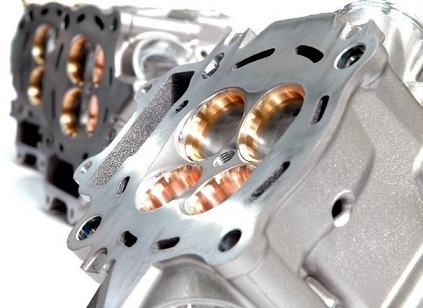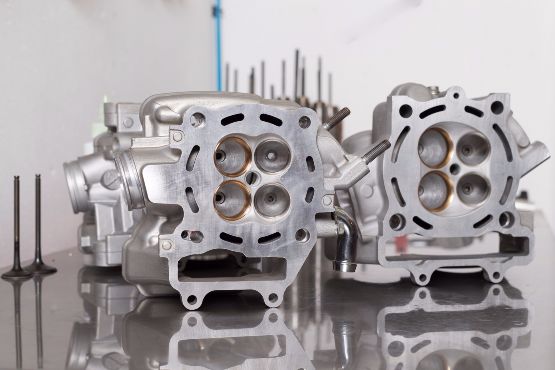MX Zone Super flowed Race Heads specialise in development and manufacture of Gas flowed cylinder heads for performance Motocross engines.
We have a range of MX Zone Gas Flowed Spec heads for Motocross applications. Our heads are developed using a gas flow bench. Often development takes many weeks to complete and is truly a black art requiring many years of experience to develop a head which truly works.
With computer modelling tools it is possible to predict engine power results. The end result is a Motocross head which not only performs as we say it will but is sold at a very reasonable price.
More about gas flowing.....

A Flow bench measures the airflow at a constant test pressure. The pressure drop is measured across the cylinder head. Using the ratio of this pressure drop to the pressure across a known (calibrated) orifice, it is possible to determine volumetric flow measured in cubic feet per minute or CFM. This is the primary measurement of the efficiency of a head.
We take readings throughout the range of valve lifts. Not just at the maximum lift of the valve. The most important part of the flow frequently occurs just as the valve is closing. The last bit of air on the intake makes the difference whether the engine obtains 90% volumetric efficiency or 100% or 110%.
To begin a typical test, you set a cylinder head on top of a cylinder adapter, with a dial indicator on the valve. A threaded bolt-type device is used to push the valve open. The spring must be stiff enough to keep the valve from being sucked open during the test.
We always use a radiused inlet guide when testing a cylinder head by itself. A radiused inlet guide has a rounded shape to guide the air into the test piece. A sharp edge at the port entrance will cause the air to flow in toward the centre of the port rather than following the port walls. The edge acts like it is choking the airflow. The flow difference can be as much as 30% due to the sharp edge effect. The radiused inlet guide directs the air straight into the port with a small loss, just as it would be if an intake manifold was connected. When an operator tests his head without a radiused inlet guide or an intake manifold, his results will be very different than your results. So it is critical to use a radiused inlet guide. The radius should be about half the width of the port. The same radiused guide is used for all comparative tests.
How does airflow capacity relate to power?
Does gas flow through the head really make that much difference? Is it really the cam that determines the flow, or is it the airflow capacity of the cylinder head?
The inlet port of a head has a single job - to allow the passage of fuel/air mix from the fuel injector / Carb at one end to the inlet valve at the other, through which it passes to the cylinder. In order to do this as smoothly and efficiently as possible, inlet ports need to be as straight and obstacle free as the design of the engine allows. The port should also promote efficient fuel/air mix by swirling and tumbling the mixture as it flows in to the cylinder.
The shape and size (volume) of the port determines the air speed and length of the column of air/fuel that enters the cylinder (measured in cubic feet per minute) and creates the essential venturi effect which affects gas velocity and mixture.
Modern cylinder heads work pretty well on the whole. They are well made, well designed and flow gas well for motors in a standard state of tune. But the limitations of mass production and cost of manufacture combined with other factors such as fuel economy and performance which is acceptable to the market means there are many compromises in the manufacture of a standard cylinder head, particularly in the port shape and surface finish.
If you are looking to improve the power of an engine, the first step might be to fit a free flowing exhaust and adjust the fuelling to suit. After that, the next stage is to have the cylinder head 'gas flowed".
Engine power is proportional to airflow, and within certain ranges, it's directly proportional to airflow. The exception to this is that if you make the port too large for the flow level, you lose some inertia supercharge effect because you've reduced the air velocity. Frequently, when flow is increased, you have to change the cam timing, and the engine will move into a higher speed range. And if you move into a different speed range, the engine will require shorter intake and exhaust lengths. There are relationships between all of these parameters.
By measuring the airflow, you can determine the potential power of the engine. If you measure 100 CFM of airflow, you can predict that that engine can only produce a certain amount of power on fuel with a defined octane rating. It's a simple equation:
For pump fuel at 10" water pressure: CFM x No. of Cylinders x 0.43 = BHP
For example: 135CFM x 4 cylinders x 0.43 = 233 BHP
Other factors must be taken in to account (that's why Port Flow Analyzer demand so many parameters and measurements) but this is a general rule of thumb for the potential of any head. The figure 0.43 is an average co-efficient seen between CFM and eventual horsepower.
It doesn't matter what else is done, you won't exceed a certain power. It's just like the throttle on a carburettor. Open it to a certain point and you get more power, and open it a little more and there is more power, and finally you end up wide-open. But, if you can flow more air, it's just the same as being able to open the throttle another 10 or 20 percent.
You can also predict the speed at which the engine will develop maximum power. As an engine draws air into the cylinder, it causes a pressure loss across the valve. The engine is pumping air into the cylinder. At a certain point, the work that it takes to pump the air in through the valve exceeds the power gained by the extra airflow that occurs.
Engines tend to peak when the maximum velocity through the valve at the maximum point in the intake cycle is about 550 to 600 feet per second. At greater velocities, the power drops. The engine will keep getting more and more power until it reaches the point where the "Mach" is 0.55, and then the power drops. You have to increase the airflow, and reduce the Mach number, in order to get power at a higher speed. Mach is ratio of air speed to the speed of sound, about 1080 feet per second at sea level.
How is a head "gas flowed"?
"Gas flowing" involves re-profiling of the inlet and exhaust ports in the cylinder head to allow the fuel/air mix to flow in and the exhaust gases to flow out more efficiently. Essentially it is a redesign of the port based on extremely accurate measurement of size and flow rates and how changes to the port affect the flow.
Of course, hidden behind the word "redesign" is a great deal of detail and pure experience of what works and what doesn't. What is too much and what is not enough. This development process relies heavily on the experience of the expert doing the job and the measurement tools available to him.
The development process of new performance heads starts with a base line measurement of the standard head. The gas flow engineer then begins to modify that port by identifying possible points which could be modified by removing material and changing the surface finish and then making that change by hand using accurate hand controlled tools. This can only be done using experience It is entirely possible to make changes that do not work or break through the head material to the water cooling circuit during development. Sometimes we have to scrap a head and start again. Knowing what works and what doesn't is where 'experience' comes in.
The changes made can then be measured and a further cycle of modification and measurement can be carried out until gas flow improvements (accurately measured) reach a point where the head can be said to be optimised (within the parameters of the head design, valve size and lift). The process is iterative and very analytical. Very subtle changes in the port make a large difference to the CFM measurement. To assist in achieving the optimum design, we use the latest gas flow bench and software to measure and record changes.
Changes made to MX Zone Motocross Race Spec heads are mainly achieved by removing material from the head which changes the shape and dynamics of the flow through the port. We also add material (by welding or using epoxy resins) to the port to change its shape in terms of flow improvement.
The Port flow analyzer software used is designed to "streamline" the recording, calculating, reporting and graphing of cylinder head flow bench data. It makes flow testing faster and more accurate and assists the experienced gas flow engineer in achieving the optimum design. It is important to realise that this technology does not do the job for the gas flow expert. In many respects it makes the job more difficult because of the sheer amount of information it can provide. However, properly used with the intuitive science of our gas flow guru, the results are outstanding.
Power improvements at the "cutting edge" of racing come from minor improvement in details. For cylinder heads, these details not only include flow, but port velocity, swirl and tumble motion. The Port Flow Analyzer software we use has options for port velocity mapping with a pilot tube, swirl and tumble measurement (using our swirl meter and our tumble adapter), port stability, etc. Using these features and the processing power of the computer (and some fairly advanced physics contained within) we are able to predict the potential power of an engine fitted with this head from the flow bench. This power prediction is amazingly accurate to within 1%
For more information please give us a ring 01225 791182
